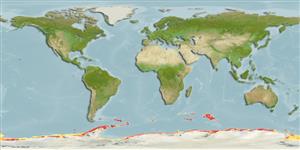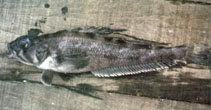Lepidonotothen squamifrons (Günther, 1880)
Grey rockcod
Add your observation in Fish Watcher
| Native range | All suitable habitat | Point map | Year 2050 |

|
| This map was computer-generated and has not yet been reviewed. |
| Lepidonotothen squamifrons AquaMaps Data sources: GBIF OBIS |
Upload your photos and videos
Pictures | Google imageLepidonotothen squamifrons
Picture by Wilhelms, S.
Pictures | Google imageLepidonotothen squamifrons
Picture by Wilhelms, S.
Common names from other countries
Classification / Names Common names | Synonyms | Catalog of Fishes(genus, species) | ITIS | CoL | WoRMS | Cloffa
Teleostei (teleosts) > Perciformes/Notothenioidei (Icefishes) > Nototheniidae (Cod icefishes) > Nototheniinae
Etymology: Lepidonotothen: Greek, lepis = scale + Greek, noton = back + Greek, adverbial particle, then, that denotes distance or remova (Ref. 45335).
More on author: Günther.
Etymology: Lepidonotothen: Greek, lepis = scale + Greek, noton = back + Greek, adverbial particle, then, that denotes distance or remova (Ref. 45335).
More on author: Günther.
Environment: milieu / climate zone / depth range / distribution range Ecology
Marine; benthopelagic; depth range 10 - 900 m (Ref. 11892), usually 195 - 312 m (Ref. 11892). Temperate; 45°S - 79°S, 180°W - 180°E (Ref. 5179)
Distribution Countries | FAO areas | Ecosystems | Occurrences | Point map | Introductions | Faunafri
Southern Ocean: South Georgia Island and Bouvet Island. Also known from sub-Antarctic islands and Antarctic Indian and Pacific Oceans.
Length at first maturity / Size / Weight / Age
Maturity: Lm 27.3, range 19 - 36 cm
Max length : 55.0 cm TL male/unsexed; (Ref. 5179); common length : 35.0 cm TL male/unsexed; (Ref. 2121); max. reported age: 19 years (Ref. 5789)
Max length : 55.0 cm TL male/unsexed; (Ref. 5179); common length : 35.0 cm TL male/unsexed; (Ref. 2121); max. reported age: 19 years (Ref. 5789)
Short description Identification keys | Morphology | Morphometrics
Dorsal spines (total): 4 - 5; Dorsal soft rays (total): 36 - 37; Anal soft rays: 29 - 33. Body with 8 or 9 long dusky crossbars, cheek with two oblique dark stripes. First dorsal fin blackish (Ref. 11892).
Feeds chiefly on macrozooplankton (mainly crustaceans, cnidarians and salps) and midwater fishes.
Life cycle and mating behavior Maturity | Reproduction | Spawning | Eggs | Fecundity | Larvae
Main reference
Upload your references | References | Coordinator | Collaborators
Dewitt, H.H., P.C. Heemstra and O. Gon, 1990. Nototheniidae. p. 279-331. In O. Gon and P.C. Heemstra (eds.) Fishes of the Southern Ocean. J.L.B. Smith Institute of Ichthyology, Grahamstown, South Africa. (Ref. 5179)
Threat to humans
Harmless
Human uses
Fisheries: minor commercial
FAO(Fisheries: production; publication : search) | FishSource | Sea Around Us
More information
Population dynamics
Growth parameters
Max. ages / sizes
Length-weight rel.
Length-length rel.
Length-frequencies
Mass conversion
Recruitment
Abundance
Growth parameters
Max. ages / sizes
Length-weight rel.
Length-length rel.
Length-frequencies
Mass conversion
Recruitment
Abundance
Physiology
Body composition
Nutrients
Oxygen consumption
Swimming type
Swimming speed
Visual pigments
Fish sound
Diseases & Parasites
Toxicity (LC50s)
Body composition
Nutrients
Oxygen consumption
Swimming type
Swimming speed
Visual pigments
Fish sound
Diseases & Parasites
Toxicity (LC50s)
Human related
Aquaculture systems
Aquaculture profiles
Strains
Ciguatera cases
Stamps, coins, misc.
Aquaculture systems
Aquaculture profiles
Strains
Ciguatera cases
Stamps, coins, misc.
Tools
E-book | Field guide | Identification keys | Length-frequency wizard | Life-history tool | Point map | Classification Tree
| Catch-MSY |
Special reports
Download XML
Internet sources
Aquatic Commons | BHL | Cloffa | Websites from users | Check FishWatcher | CISTI | Catalog of Fishes(genus, species) | DiscoverLife | ECOTOX | Faunafri | Fishtrace | GenBank(genome, nucleotide) | GloBI | GOBASE | | Google Books | Google Scholar | Google | IGFA World Record | MitoFish | Otolith Atlas of Taiwan Fishes | PubMed | Reef Life Survey | Scirus | SeaLifeBase | Tree of Life | Wikipedia(Go, Search) | World Records Freshwater Fishing | Zoological Record
Estimates based on models
Preferred temperature (Ref. 115969): 1.3 - 2.8, mean 1.7 (based on 21 cells).
Phylogenetic diversity index (Ref. 82804): PD50 = 1.0000 [Uniqueness, from 0.5 = low to 2.0 = high].
Bayesian length-weight: a=0.00468 (0.00395 - 0.00554), b=3.24 (3.19 - 3.29), in cm Total Length, based on LWR estimates for this species (Ref. 93245).
Trophic level (Ref. 69278): 3.5 ±0.52 se; based on food items.
Resilience (Ref. 120179): Low, minimum population doubling time 4.5 - 14 years (K=0.08-0.12; tm=7-9; tmax=19; Fec = >10,000).
Fishing Vulnerability (Ref. 59153): High to very high vulnerability (67 of 100).
Climate Vulnerability (Ref. 125649): High vulnerability (55 of 100).




